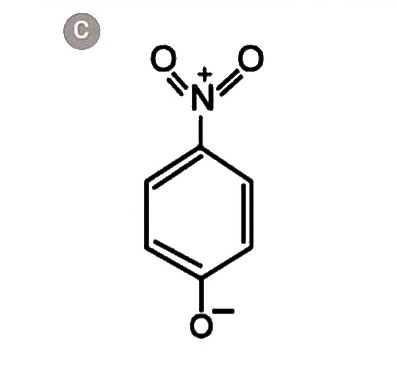The most unlikely resonating structures of pnitrophenoxide ion is :




The correct Answer is:C
To determine the most unlikely resonating structure of the para-nitrophenoxide ion, we will analyze the given options based on the rules of resonance and the valency of the atoms involved.
1. Understanding Para-Nitrophenoxide Ion:
- The para-nitrophenoxide ion is derived from para-nitrophenol by deprotonation (removal of a hydrogen ion). The structure consists of a phenolic ring with a nitro group (–NO2) at the para position and an oxygen atom with a negative charge (–O⁻).
2. Drawing the Resonating Structures:
- The para-nitrophenoxide ion can exhibit resonance. The negative charge on the oxygen can delocalize through the aromatic ring and the nitro group.
- Possible resonating structures include:
- Structure 1: O⁻ with a double bond to the carbon, and a double bond between the nitrogen and one of the oxygens in the nitro group.
- Structure 2: The negative charge can shift to the carbon atom adjacent to the oxygen, creating a double bond between the oxygen and the carbon.
- Structure 3: The negative charge can also be delocalized to the nitrogen atom, resulting in a positive charge on the nitrogen.
3. Evaluating the Given Options:
- Option A: This structure is valid as it maintains the octet rule and shows proper charge separation.
- Option B: This structure is also valid as it shows a correct distribution of charges and bonds.
- Option C: This structure shows nitrogen with five bonds, which is not possible as nitrogen can only form a maximum of four bonds (due to its tetravalency). This makes it an unlikely resonating structure.
- Option D: This structure is valid as it maintains proper bonding and charge distribution.
4. Conclusion:
- The most unlikely resonating structure of para-nitrophenoxide ion is Option C, as it violates the octet rule for nitrogen.
- The para-nitrophenoxide ion is derived from para-nitrophenol by deprotonation (removal of a hydrogen ion). The structure consists of a phenolic ring with a nitro group (–NO2) at the para position and an oxygen atom with a negative charge (–O⁻).
- The para-nitrophenoxide ion can exhibit resonance. The negative charge on the oxygen can delocalize through the aromatic ring and the nitro group.
- Possible resonating structures include:
- Structure 1: O⁻ with a double bond to the carbon, and a double bond between the nitrogen and one of the oxygens in the nitro group.
- Structure 2: The negative charge can shift to the carbon atom adjacent to the oxygen, creating a double bond between the oxygen and the carbon.
- Structure 3: The negative charge can also be delocalized to the nitrogen atom, resulting in a positive charge on the nitrogen.
- Option A: This structure is valid as it maintains the octet rule and shows proper charge separation.
- Option B: This structure is also valid as it shows a correct distribution of charges and bonds.
- Option C: This structure shows nitrogen with five bonds, which is not possible as nitrogen can only form a maximum of four bonds (due to its tetravalency). This makes it an unlikely resonating structure.
- Option D: This structure is valid as it maintains proper bonding and charge distribution.
- The most unlikely resonating structure of para-nitrophenoxide ion is Option C, as it violates the octet rule for nitrogen.
Similar Questions
Knowledge Check
The most stable resonating structure of p-nitrosobenzene is :
A B
B C
C D
D
The most unlikely representation of resonance structures of p-nitrophenoxide ion is :
A B
B C
C D
D
The most stable resonating structure of the following molecule is :
 A
A B
B C
C D
D
The most unlikely representation of resonance structures of p-nitrophenoxide ion is :
View SolutionWrite resonating structure of the compound

View SolutionWrite the resonance structure of nitrous oxide.
View SolutionLeast contributing resonating structure of nitroethene is :
View SolutionThe most unlikely representation of resonance structure of p-nitrophenoxide is :
View Solution

